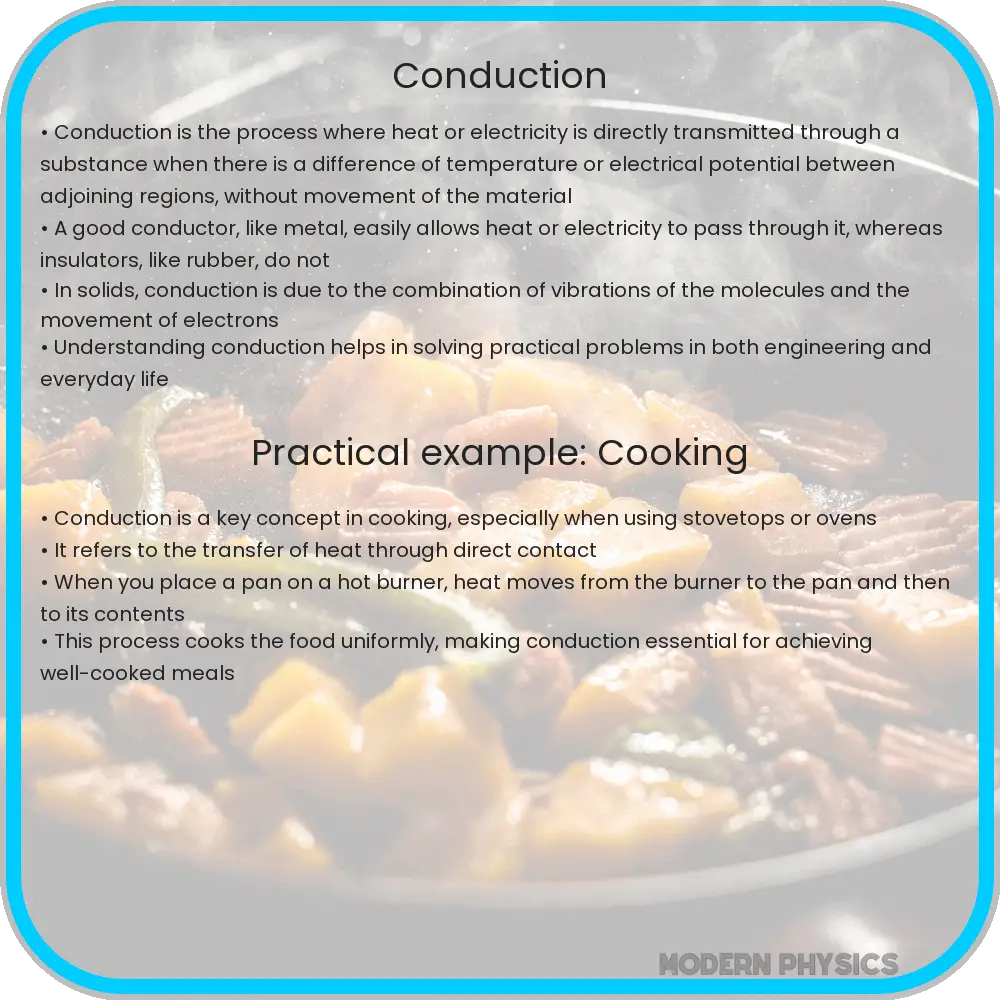Explore the fundamentals of heat transfer through conduction, its efficiency, material impact, and advances in thermal management technologies.

Understanding Conduction in Heat Transfer
Conduction is a fundamental method of heat transfer where thermal energy moves through a material without any physical movement of the substance itself. It is a process that is pivotal in many areas of science and engineering, affecting everything from household cooking to industrial processes. In this article, we delve into the mechanisms of conduction, its efficiency, and how different materials influence its effectiveness.
How Does Conduction Work?
At a microscopic level, conduction occurs as atoms or molecules in a high-temperature area vibrate more vigorously. These vibrations transfer energy to neighboring particles, causing them to increase in thermal energy. This chain reaction of energy transfer continues until there is an equilibrium of temperature across the material. The rate of heat transfer by conduction is dependent on several factors, such as the temperature gradient, the material’s cross-sectional area, and the distance the heat travels.
Factors Influencing Conduction Efficiency
- Material Properties: The efficiency of conduction varies significantly with different materials. Metals, for instance, are excellent conductors due to the presence of free electrons that facilitate the transfer of heat. Non-metals, particularly gases, are poor conductors as they have fewer free electrons.
- Temperature Gradient: The greater the difference in temperature between the two ends of a material, the faster the rate of heat transfer. This is quantified by Fourier’s Law of Heat Conduction.
- Thickness of the Material: Thicker materials hinder the rate of heat transfer, as heat must travel a greater distance through the substance.
Materials and Their Conductive Properties
Materials play a crucial role in conduction. Conductors, such as copper (Cu) and silver (Ag), have high thermal conductivity. Insulators like wood and styrofoam have low thermal conductivity and are used to prevent heat loss. Advances in material science have led to the development of materials with tailored thermal properties, such as aerogels and thermal interface materials, which have applications in aerospace, electronics, and building insulation.
Understanding the principles of conduction is essential for designing efficient thermal management systems in various technological and industrial applications. The choice of material, along with its inherent properties, significantly impacts the efficiency of heat transfer in any system.
Enhancing Conduction Efficiency
Improving conduction efficiency is a key goal in many industries. This can be achieved through material selection and engineering design. For instance, heat sinks in electronic devices are often made of aluminum or copper, leveraging their high conductivity. Similarly, in building construction, materials are chosen based on their ability to either conduct heat efficiently or insulate against it, depending on the desired outcome.
Technological Advancements and Future Directions
Recent technological advancements have introduced materials like graphene and carbon nanotubes, known for their exceptional thermal properties. These materials are being explored for use in high-efficiency thermal management systems. Additionally, research is ongoing into the development of metamaterials, which can conduct heat in specific directions or exhibit tunable conductivity.
Conduction in Everyday Life
In everyday life, conduction is a phenomenon we encounter regularly. From cooking on a stovetop to the warmth of a heated blanket, conduction plays a vital role. Understanding this process helps in making informed choices about materials and appliances we use daily.
Conduction and Environmental Impact
Efficient thermal management through improved conduction is also significant for environmental sustainability. Better insulation materials in buildings can reduce energy consumption for heating and cooling. Similarly, efficient heat transfer in industrial processes can lead to reduced energy use and lower greenhouse gas emissions.
Conclusion
In conclusion, conduction is a key mode of heat transfer that influences numerous aspects of our daily lives and various industrial processes. The efficiency of conduction depends on the material properties, temperature gradients, and the physical dimensions of the conducting medium. Advances in material science, like the development of graphene and metamaterials, offer exciting possibilities for enhancing conduction efficiency. As we continue to explore and understand the nuances of thermal conduction, we pave the way for more efficient, sustainable, and innovative applications in technology, industry, and everyday life. Ultimately, the mastery of heat transfer through conduction is a testament to human ingenuity and a crucial element in our pursuit of technological advancement and environmental stewardship.
